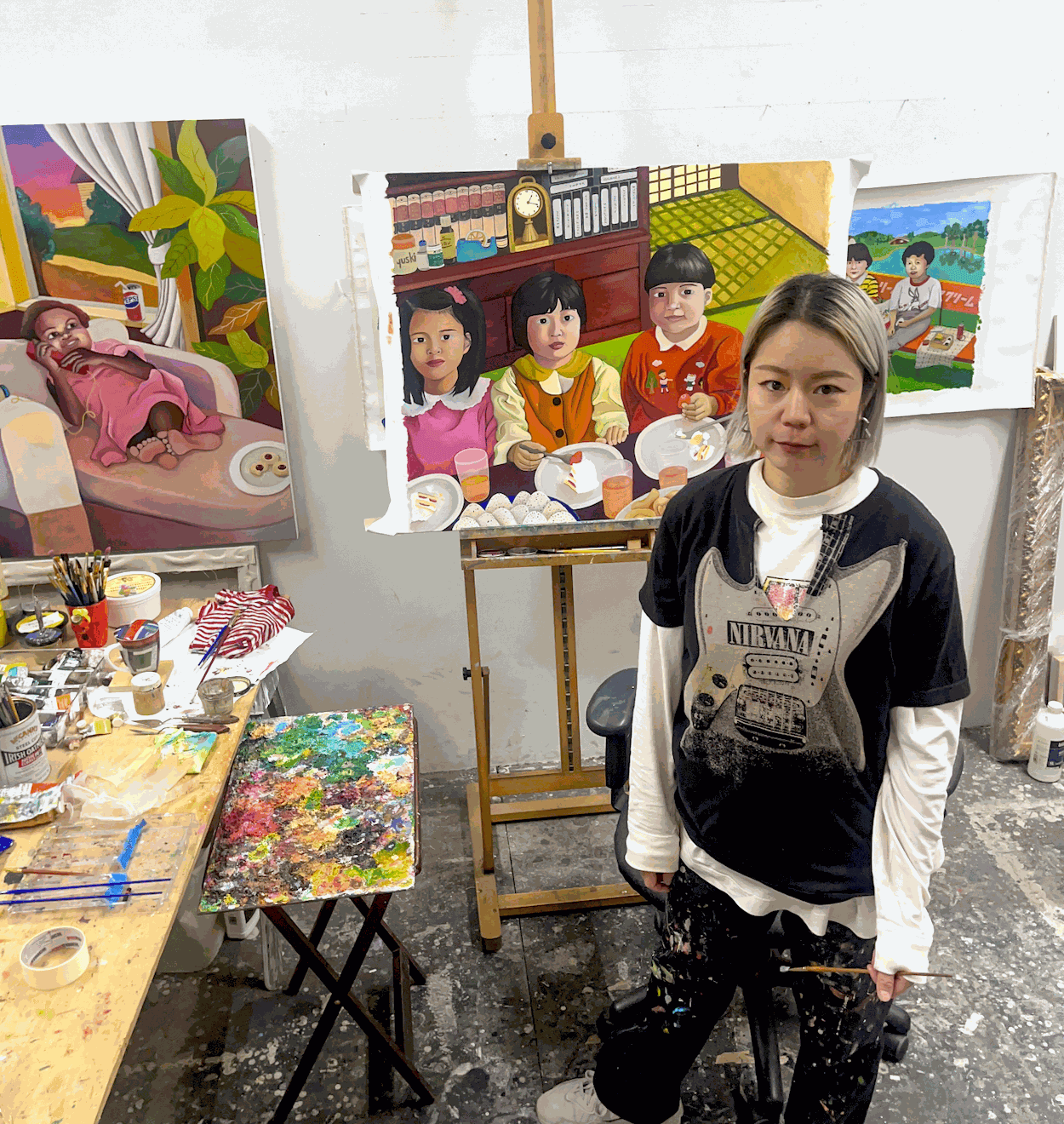
When I immigrated to the United States, I never imagined that I would pursue becoming an artist in New York City.
After graduating design school in Osaka, Mayumi Nakao (b. 1985, Kobe) realized her long-held dream of living abroad and moved to New York alone in 2013.
Encounters with artists from all over the world who came to New York to pursue their artistic dreams significantly changed her life. Inspired by their work and passionate efforts, she enrolled in the Art Students League where she began creating works using oil painting techniques.
In 2022, she held her first solo exhibition in New York. In 2023, she also held a solo exhibition in Tokyo. Additionally, she has participated in numerous group exhibitions. In 2023, she was selected as one of the ten finalists for the Women Figurative Realist Painters category of The Bennett Prize, which targets female artists across the United States, and exhibited her works at the Muskegon Museum of Art in Michigan. Furthermore, she actively participates in art residencies such as Artist Recidency La Fourchette de Rose in Ivory Coast.

(Mayumi Nakao in her studio)
AN: Please tell us about the journey until becoming an artist after moving to New York in 2013.
MN: Initially, when I moved to the United States, I never imagined that I would pursue becoming an artist in New York City. New York City is truly fast-paced, with artists from all over the world coming with passion to challenge themselves in its art scene. Witnessing their dedication firsthand was inspiring. I started with only the ambition and curiosity to try it out in New York. When I entered an art school in New York, I got to know an artist whom I consider my mentor and learned the joy of oil painting. Being in an environment where my art was appreciated by others fueled my desire to improve and express myself more. I painted every day, sometimes spending from morning till late night, tirelessly creating paintings with no planned exhibition venues. Eventually, I started receiving opportunities for exhibitions little by little from artist friends and galleries, which has led me to where I am today.
AN: Regarding your current style, many motifs are intricately depicted on a single canvas. Why do you paint in such detail?
MN: I enjoy adding small details. By incorporating well-known characters and product packaging, viewers can relate, and including nostalgic colors and everyday items fosters a sense of familiarity, making it easier for viewers to immerse themselves in the painting.
I particularly enjoy depicting scenes of meals. Food is an essential element. Through food, you can sense the atmosphere of a household, the culture of a country, and even the era. I hope viewers can enjoy imagining freely while looking at my work, perhaps feeling like they're having a meal with the depicted family or reminiscing about their childhood experiences with certain characters.

AN: The expressions of the people in your paintings are also very rich.
MN: That's pleasing to hear. Since people primarily focus on the characters when looking at a painting featuring individuals, I prioritize facial expressions and spend time on them. While many expressions may seem ambiguous, I hope viewers can still perceive the emotions conveyed.
Both they and I, immigrants to America with our own roots, felt a connection despite differences in culture, race, and expression. I wanted to depict those warm feelings and nostalgia.
AN: I'm curious, why do you often paint black people?
MN: During a figure drawing class at the Art Students League, we happened to have a Black model. Their skin had various tones, with hues of blue or pink, which was intriguing. I found it fascinating and wanted to explore more, so I borrowed photographs from my African American friends. As I looked at their photos and heard their family stories, it became personal. Both they and I, immigrants to America with our own roots, felt a connection despite differences in culture, race, and expression. I wanted to depict those warm feelings and nostalgia.
AN: It seems natural that your style emerged in the diverse environment of New York. Does it carry a meaning related to the Black Lives Matter movement?
MN: That's a question I often receive, but no, it doesn't. When the Black Lives Matter movement gained momentum again during the pandemic in New York, I did contemplate why, as an Asian, I paint Black individuals. I wondered if incorporating such themes in my work could contribute to the discussion on racial issues. However, I started painting Black people simply because I resonated with the stories of my friends' families and felt compelled to depict them. I realized it wouldn't be appropriate to align my work with that issue because it stemmed purely from personal emotions and not from activism. Of course, I support Black Lives Matter. When painting individuals of different races, it's essential to understand their backgrounds and respect their rights. Since I began painting Black families in 2018, I've been consciously seeking more opportunities to learn about their history and background.
AN: What inspires your artwork?
MN: I often draw inspiration from old photographs of friends. Since I often imagine the atmosphere of the early 1990s, I find inspiration in American sitcoms, movies, interior design books from that era, and various aspects of daily life, such as conversations with friends, scenes observed during walks, and experiences while traveling. Additionally, New York has numerous museums and art galleries where I can view works by various artists, providing ample inspiration. The challenge and curiosity to incorporate such inspiration into my work or try something new in my next piece are now significant driving forces.

(Mayumi's latest work where she takes inspiration from her own childhood in Japan)
AN: Do you have a theme you want to convey in this exhibition?
MN: I naturally have overarching themes of "sharing nostalgia" and "narrativity," but in this exhibition, alongside my previous works featuring Black families, I also present paintings of myself and my own family for the first time. Thus, I titled it "Sweet Memories."
I believe Japanese viewers will feel nostalgic and warm when they see it, while viewers from other countries may experience it differently. I plan to mix various elements in this exhibition. Furthermore, I hope this serves as an opportunity for me to incorporate more of my past and Japanese culture into my future works.
AN: Is "nostalgia" a significant point for you?
MN: This style emerged in 2018. Before that, I used to draw American old diners and depicted old parfaits and milkshakes. I think I'm drawn to such nostalgic elements. For my generation, the late 1980s to early 1990s is nostalgic, and I've heard older generations say they find it warm and nostalgic as well. Nostalgia is a feeling I personally enjoy; it's a kind emotion that evokes kindness.




